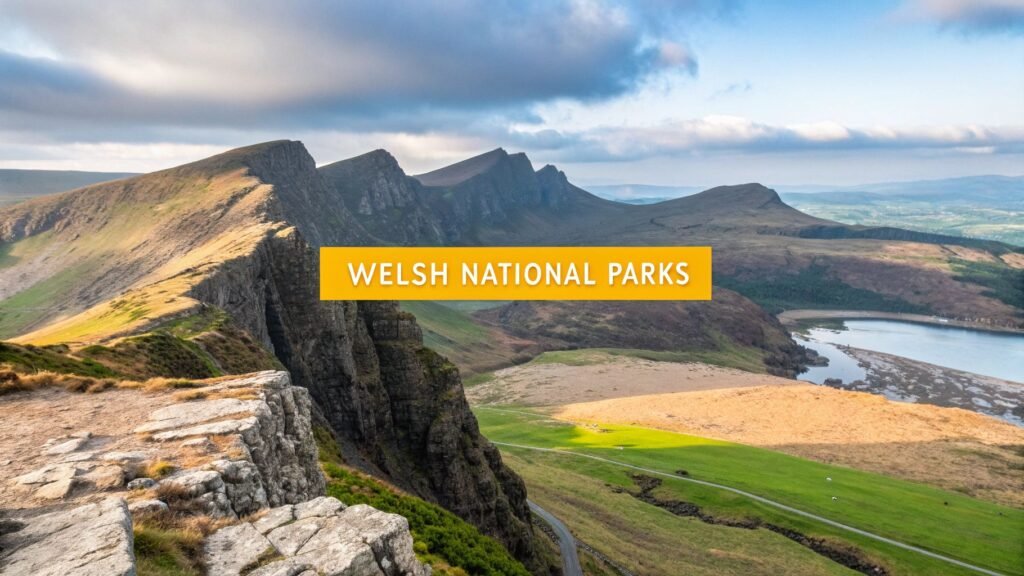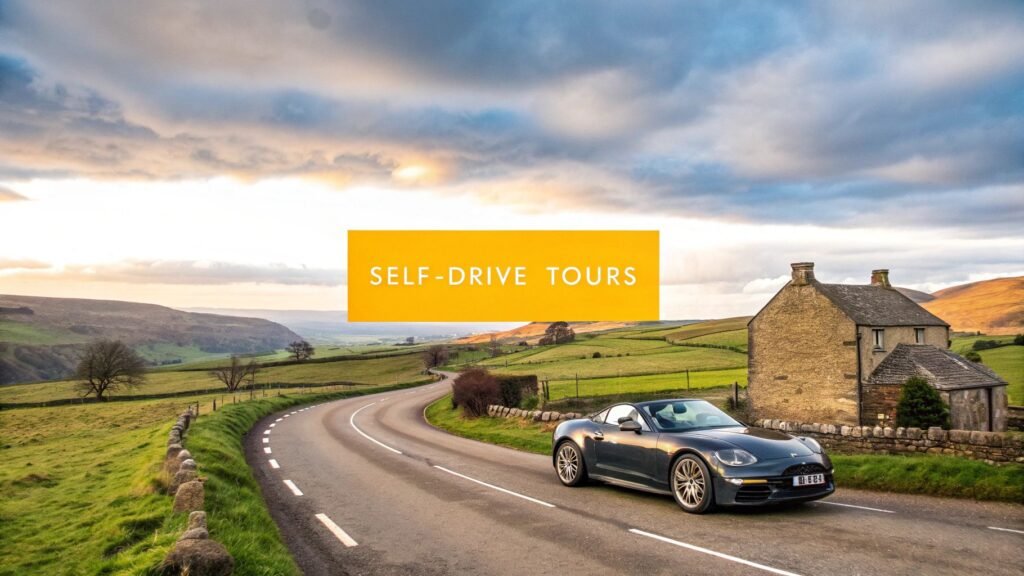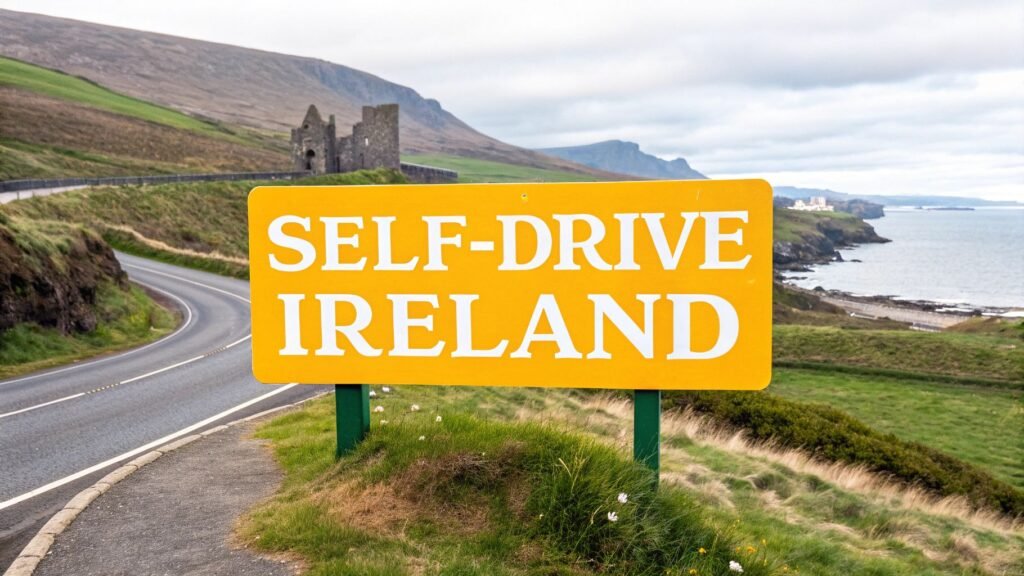Wales is home to three incredible national parks: Snowdonia (Eryri), the Brecon Beacons (Bannau Brycheiniog), and the Pembrokeshire Coast. It's an amazing fact, but together, these protected areas cover nearly 20% of the entire country, showcasing everything from jagged mountain peaks and sprawling green hills to some of the most dramatic coastline you'll ever see.
A Journey Through Wales's Protected Landscapes
I like to think of the three national parks in Wales as having their own distinct personalities. While they all promise stunning beauty and proper outdoor adventure, they feel completely different from one another. It's this variety that really gets to the wild heart of the nation.
You've got the ancient, myth-steeped mountains in the north, the serene, rolling hills in the south, and the wild, sea-battered cliffs of the west. To truly get a feel for Wales's natural heritage, you have to experience them.
This guide is here to act as your compass, helping you get to know each park so you can figure out which one is calling your name. Whether you're after a high-altitude challenge, a peaceful ramble through waterfall country, or the salty air of a coastal trail, one of these parks is the perfect fit. For a wider view of what the country has in store, have a look at our complete guide for planning an adventure in Wales.
Getting to Know the Three Parks
The story of these parks began back in the 1950s. Between 1951 and 1957, all three were officially established, a brilliant move that has protected some of the most iconic landscapes in the UK for all of us to enjoy.
To get a clearer picture, here’s a quick introduction to each park’s character:
- Snowdonia (Eryri): This is the heavyweight champion. It’s the largest, the oldest, and home to the highest peaks, dramatic glacial valleys, and a deep sense of myth and legend.
- Brecon Beacons (Bannau Brycheiniog): Think sweeping green hills, heather-topped moorland, and magical waterfalls. It's also famously recognised as an International Dark Sky Reserve, making it a stargazer's paradise.
- Pembrokeshire Coast: A true one-off, this is the UK’s only national park that's almost entirely coastal. It’s defined by its world-famous coast path, which winds past staggering cliffs, pristine sandy beaches, and tiny, hidden coves.
Wales's Three National Parks at a Glance
To make it even simpler, this little table breaks down the essentials of each park, helping you match your ideal adventure with the right location.
| National Park | Best For | Key Landscape | Signature Activity |
|---|---|---|---|
| Snowdonia (Eryri) | Mountain hiking & dramatic scenery | Towering peaks, deep valleys, slate quarries | Climbing Yr Wyddfa (Snowdon) |
| Brecon Beacons (Bannau Brycheiniog) | Stargazing, waterfalls & peaceful walks | Rolling green hills, moorland, forests | Exploring the Four Waterfalls Walk |
| Pembrokeshire Coast | Coastal walking & seaside villages | Towering cliffs, sandy beaches, estuaries | Hiking sections of the Coast Path |
Ultimately, choosing between them isn’t about finding the 'best' park, but about finding the one whose personality and landscape best match the kind of experience you’re looking for.
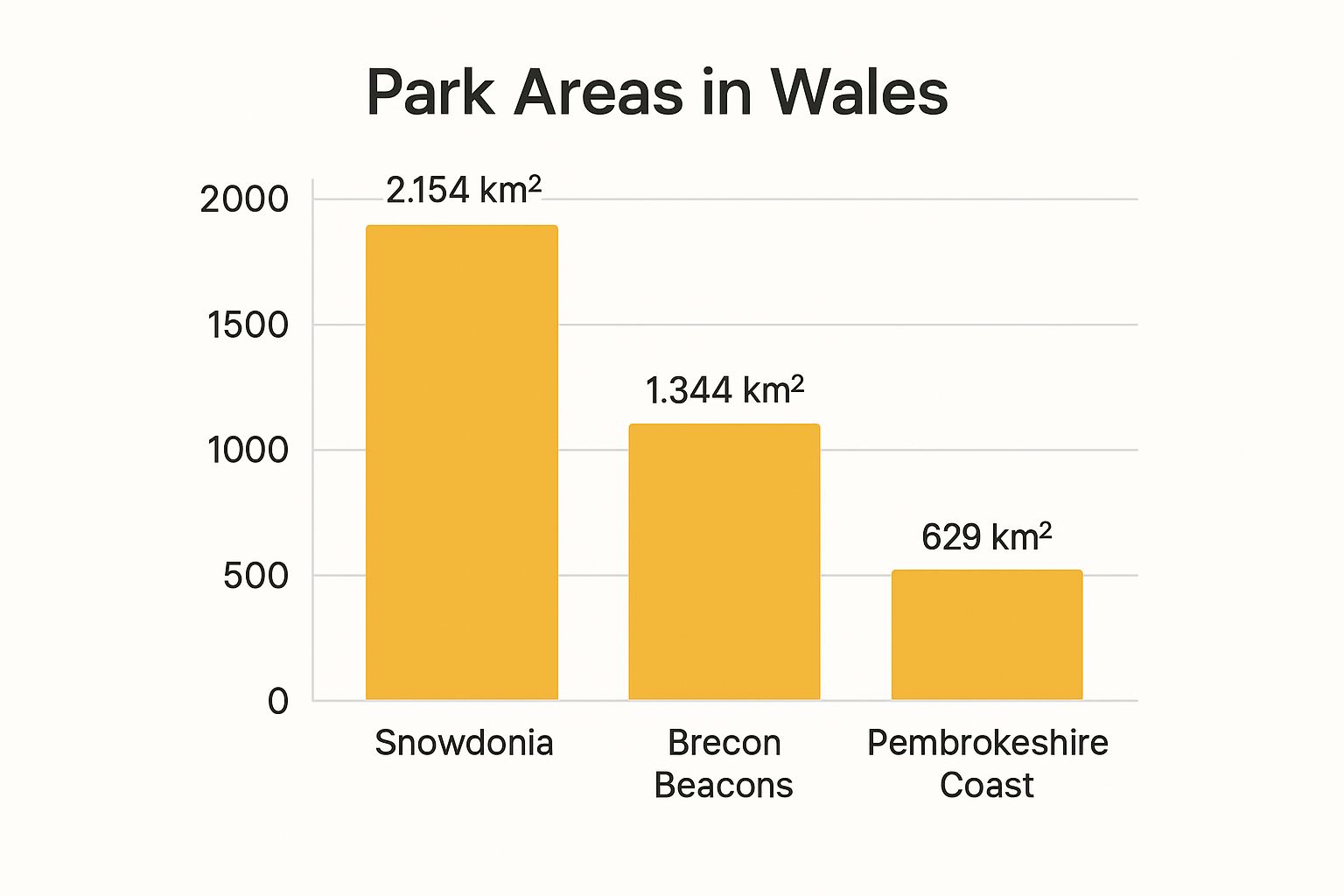
As you can see, Snowdonia is by far the biggest, a vast wilderness of mountains and valleys, while the Pembrokeshire Coast is much more focused, hugging that magnificent shoreline.
Conquering the Peaks of Snowdonia (Eryri)
Welcome to Snowdonia, or Eryri as it’s known in Welsh—a land of giants carved by ice and steeped in myth. This is far more than just a spot on the map. It's the largest of the national parks in Wales and an epic stage for some of the most dramatic landscapes in the UK. While most people know it for Yr Wyddfa (Snowdon), the highest peak in Wales and England, the park's real soul is found in its sheer scale and variety.
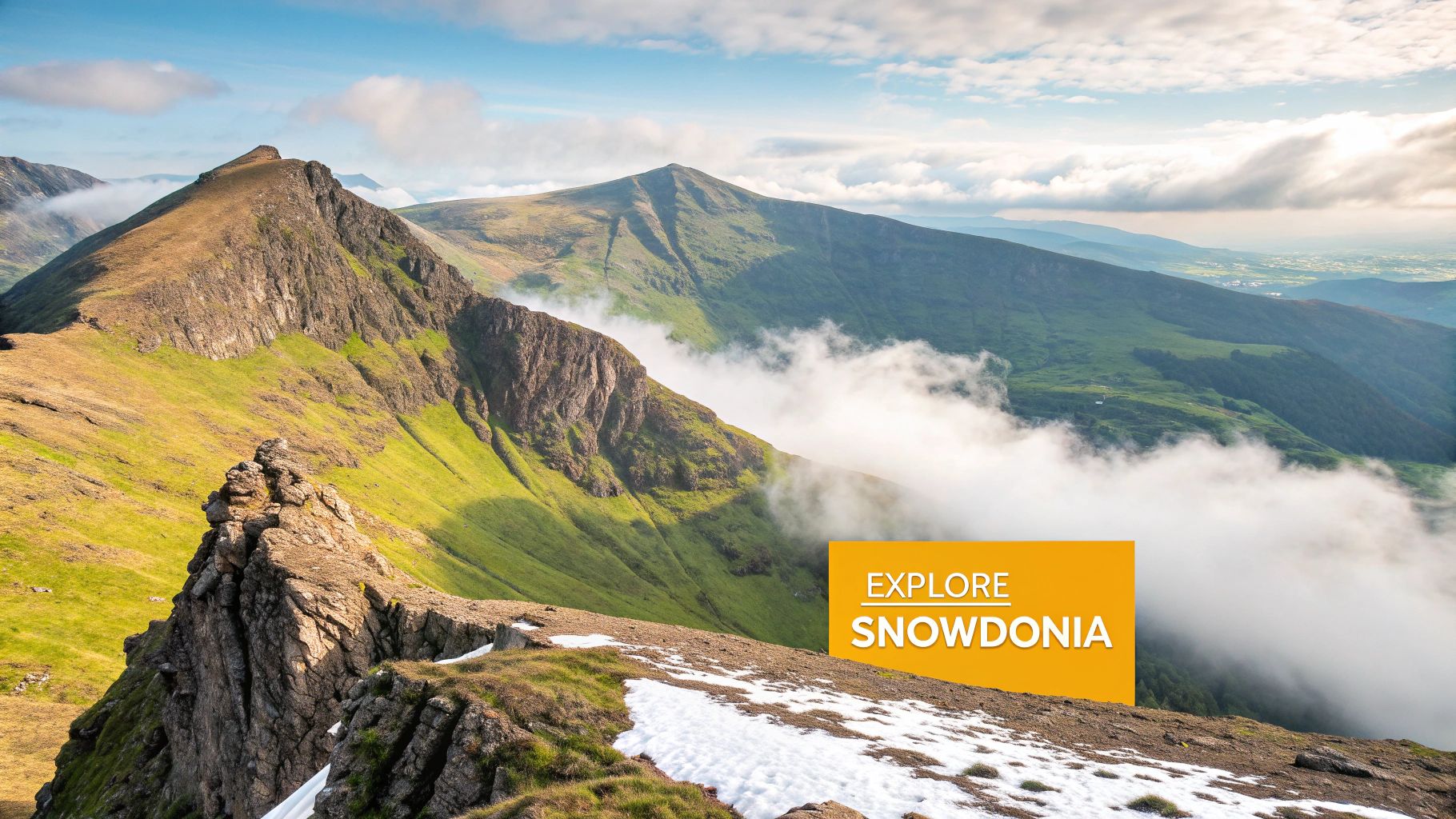
Picture deep, glacier-gouged valleys cradling serene lakes, ancient oak forests that feel like they're whispering old tales, and a rugged coastline meeting the Irish Sea. This is a landscape where every corner holds a story, from the slate industry remnants that once roofed the world to legends of King Arthur sleeping beneath the mountains. Snowdonia challenges you physically, but it also connects you deeply to Welsh culture.
Essential Trails for Every Walker
The trails here are as diverse as the scenery, with something for everyone from casual strollers to seasoned mountaineers. You don’t have to climb the highest peak to feel the magic.
- Llanberis Path: This is the most popular and gradual route up Yr Wyddfa, making it a great choice if it’s your first time. It follows the path of the mountain railway, offering a steady incline and reassuring views all the way up.
- Miners' Track: A real walk of two halves. It starts gently, winding past the beautiful Llyn Llydaw and the ruins of the Britannia Copper Mine, before throwing a steep, challenging scramble at you to reach the summit. It’s a bit of history mixed with a proper mountain workout.
- Cwm Idwal Walk: Looking for a fantastic lower-level option? This circular trail takes you into a dramatic glacial amphitheatre. The path around Llyn Idwal is manageable for most and serves up some of the most striking mountain scenery in Britain without a major ascent.
To really make the most of the tougher climbs, you might want to enhance your endurance for challenging hikes.
Scenic Drives Through the Heart of the Park
Getting behind the wheel in Snowdonia lets you truly appreciate the scale of the landscape. The roads here are destinations in themselves, twisting through epic mountain passes that demand your attention.
The Llanberis Pass (A4086) is arguably the most famous drive, slicing right through the Snowdon massif. As you navigate its winding tarmac, you're flanked by towering cliffs and scree slopes, with trailheads for popular climbs peeling off along the way.
Another unmissable route is the A498 from Beddgelert to Capel Curig. This road offers absolutely stunning perspectives of the Snowdon Horseshoe and the beautiful Llyn Gwynant, with plenty of lay-bys that are perfect for pulling over to just soak it all in.
Must-Visit Villages and Cultural Hubs
The villages scattered throughout Snowdonia are the lifeblood of the park. Each one has its own unique charm and a warm Welsh welcome waiting for you. They aren't just bases for adventure; they're destinations rich in character and history.
Betws-y-Coed, often called the 'Gateway to Snowdonia', is a bustling hub full of Victorian architecture, outdoor gear shops, and lovely riverside walks. It’s the perfect spot to stock up on supplies or enjoy a well-earned meal after a day out.
For a real glimpse into the region’s industrial past, make your way to Llanberis. Nestled at the foot of Yr Wyddfa, it’s home to the National Slate Museum and the starting point for the Snowdon Mountain Railway. It’s a village that masterfully blends its rugged heritage with its modern role as an adventure capital.
Discovering the Pembrokeshire Coast Path
Right, let's leave the mountains behind and head west, all the way to the edge of Wales where the land tumbles into the sea. This is the Pembrokeshire Coast National Park, a place so utterly unique it’s the only national park in the UK created specifically for its coastline. It’s a raw, beautiful landscape shaped by the full force of the Atlantic, which has spent millennia carving out dramatic cliffs, hidden coves, and vast stretches of golden sand.
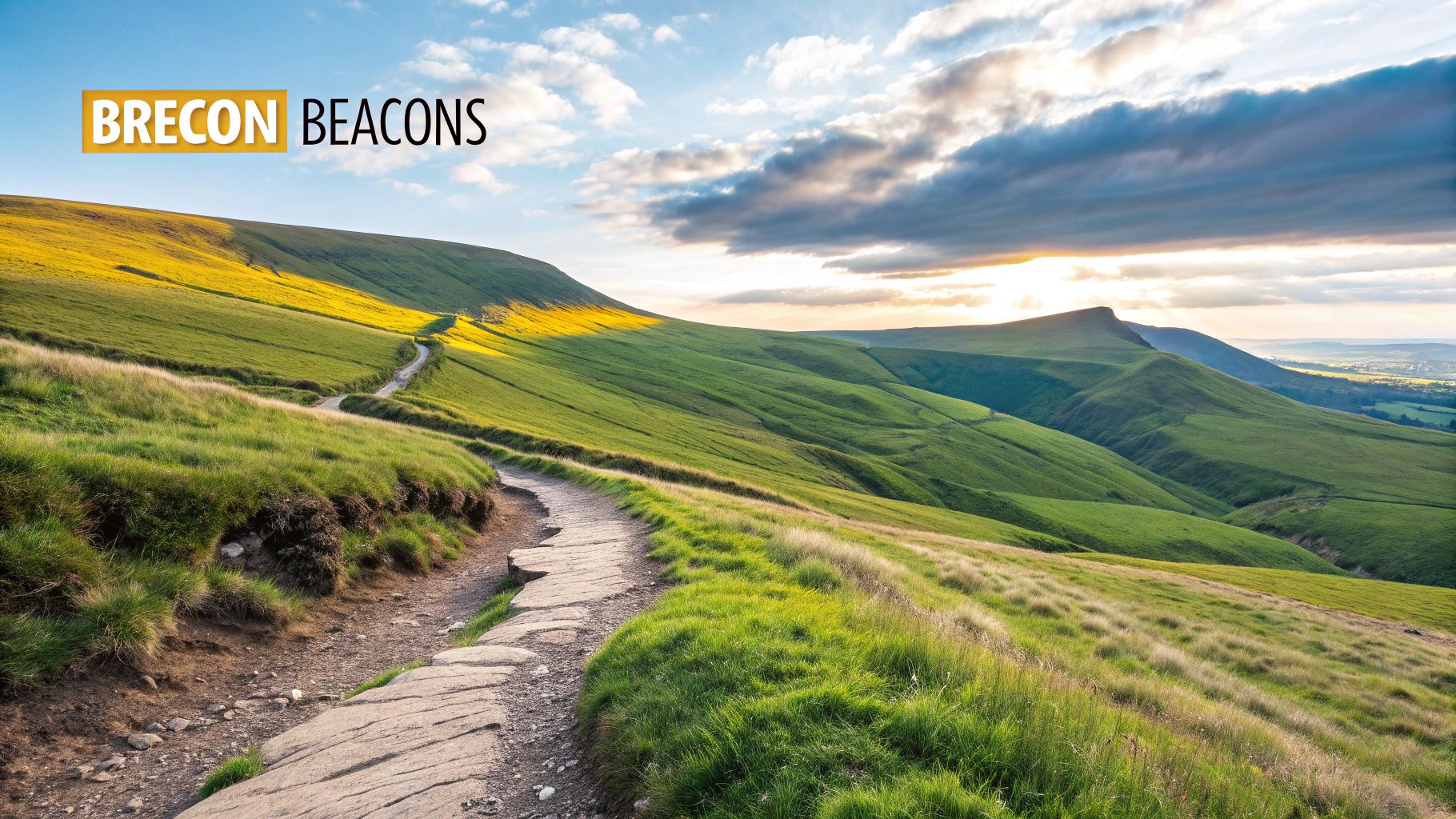
Unlike the towering peaks of Snowdonia or the rolling hills of the Brecon Beacons, Pembrokeshire's magic is all about its relationship with the water. The park itself is a long, thin ribbon of protected land that literally hugs the shore. Running through its heart is the world-famous Pembrokeshire Coast Path, a continuous 186-mile (299 km) trail that showcases some of the most breathtaking coastal scenery Britain has to offer.
Walking the World-Famous Coast Path
The Coast Path is a walker's dream, but you don't have to be a seasoned trekker to fall in love with it. The trail is brilliantly accessible, easily broken down into manageable chunks perfect for a gentle afternoon stroll, a rewarding half-day hike, or even a full-blown multi-day adventure.
Think of the path as a highlight reel of coastal geography. One moment you're standing on a windswept clifftop with endless views over the Irish Sea; the next, you're dropping down into a tranquil, sheltered estuary brimming with birdlife. It’s this constant variety that makes every step feel new and exciting.
To walk the Pembrokeshire Coast Path is to walk through a gallery of geological time. Every cove, cliff, and headland tells a story written by the sea over millions of years.
If you’re just looking for a taste of the trail, here are a few sections I always recommend:
- Barafundle Bay to Broad Haven South: This is a fairly easy walk that leads you to one of Britain's most beautiful beaches, Barafundle Bay, which genuinely looks like it belongs in the Caribbean. You'll also pass the incredible sea stacks at Stackpole Quay.
- Strumble Head: For something a bit more wild and rugged, head to this northern section. It’s a fantastic spot for wildlife watching, with the dramatic lighthouse as your focal point and cliffs that are home to countless seabirds and seals.
- Marloes Sands to Martin's Haven: This walk is all about the area's striking red sandstone cliffs and offers sweeping views out towards Skomer Island. At low tide, the beach at Marloes Sands reveals a geological wonderland of rock formations.
Beyond the Path: Key Attractions
While the Coast Path is the main event, the park is also dotted with charming towns and historic sites that are well worth exploring.
You simply have to visit the colourful harbour town of Tenby. Its pastel-painted Georgian houses huddle around the harbour, all tucked behind sturdy medieval stone walls. It’s the perfect place to grab some fresh seafood, relax on one of its three sandy beaches, and just soak up the classic seaside atmosphere.
A little further west you’ll find St Davids, which holds the title of the UK’s smallest city. In reality, it feels more like a village, but its magnificent cathedral and the romantic ruins of the Bishop's Palace give it official city status. There's a real sense of peace and history here, all just a short walk from the wild coastline.
A Haven for Wildlife
Pembrokeshire is one of the best places in the UK for wildlife, especially when it comes to marine life. The offshore islands here are internationally important breeding grounds for seabirds.
If you can, take a boat trip to Skomer Island between April and July. It's an experience you'll never forget. The island is home to the largest puffin colony in southern Britain, and these comical, charismatic birds are so unafraid of people you can get incredibly close. It is a true wildlife spectacle.
Even on the mainland, keep your eyes peeled. The waters are home to a huge population of Atlantic grey seals, which you can often spot bobbing in the surf or lazing on the rocks. Dolphins and porpoises are regular visitors too, turning any coastal walk into a potential safari. If this blend of coast and culture appeals, you might enjoy a wider trip that takes in the best of South England and Wales.
Exploring the Brecon Beacons (Bannau Brycheiniog)
While Snowdonia might be the rugged, dramatic giant of the north, the Brecon Beacons (Bannau Brycheiniog in Welsh) is the soulful green heart of South Wales. This is a landscape of sweeping grassy moorlands, heather-clad hills, and enchanting valleys where waterfalls hide away in ancient woodlands. It offers a softer, more tranquil experience than its northern counterpart, but don't be fooled—it's every bit as wild and captivating.
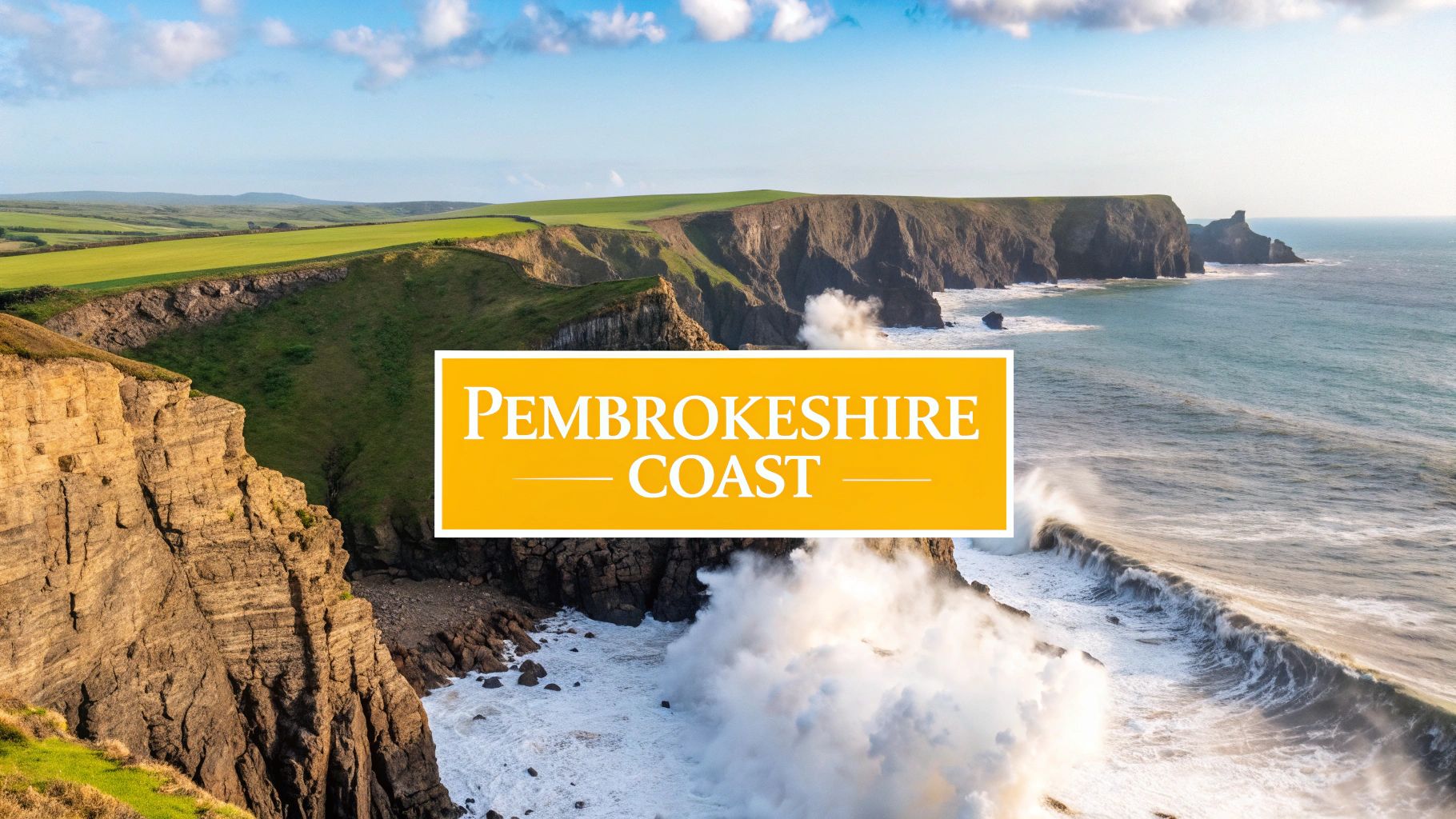
The park is really defined by its vast open spaces and the distinctive, flat-topped mountains that rise like sleeping giants from the Usk Valley. It's a place that just begs you to take a deep breath and slow down, whether you're trekking along a remote ridgeline, cycling by a peaceful canal, or simply staring up at a sky blanketed in stars.
The Crown Jewel of South Wales: Pen y Fan
The Beacons might offer a different kind of challenge to Snowdonia, but they certainly aren't short on iconic peaks. The most famous of them all is Pen y Fan, which, at 886 metres, is the highest point in southern Britain. Getting to its flat-topped summit is a rite of passage for many walkers, and the panoramic views you're rewarded with are nothing short of spectacular.
On a clear day, your gaze can stretch right across the Bristol Channel to Somerset and Devon. There are a few ways to the top, from the very popular and direct "motorway" path starting at the Storey Arms to more challenging circular hikes that feel much more rewarding.
If you’re up for a real test, the Pen y Fan Horseshoe is magnificent. It's a demanding nine-mile loop that also takes in the neighbouring peaks of Corn Du and Cribyn, giving you a true sense of the sheer scale and grandeur of the central Beacons.
Delving into Waterfall Country
One of the most magical corners of this national park is an area rightly named Waterfall Country. Tucked away in the park's southwestern corner near Ystradfellte, this is where rivers have spent millennia carving through soft sandstone, creating a wonderland of gorges, caves, and, of course, absolutely stunning waterfalls.
The famous Four Falls Trail is a must-do. This moderate four-mile walk guides you through beautiful, ancient woodland to four spectacular cascades:
- Sgwd Clun-Gwyn: The "fall of the white meadow."
- Sgwd Isaf Clun-Gwyn: A series of smaller, but equally beautiful, falls.
- Sgwd y Pannwr: The "fall of the woollen-washer."
- Sgwd-yr-Eira: The "fall of snow," where you can actually walk right behind the curtain of water.
That feeling of standing behind the thundering water at Sgwd-yr-Eira is something you won't forget, connecting you directly to the raw power of nature. For a shorter walk with an equally impressive payoff, head to Henrhyd Falls. At 90 feet, it’s the tallest waterfall in South Wales and was famously used as the entrance to the Batcave in The Dark Knight Rises.
A Sky Full of Stars
The Brecon Beacons holds a very special status that sets it apart. In 2012, it was designated an International Dark Sky Reserve—only the fifth destination in the world to receive such an honour at the time. This recognition means the park is fiercely protected from light pollution, offering some of the best stargazing you’ll find anywhere in the UK.
On a clear, moonless night, the sky above the Brecon Beacons completely transforms. You can see the Milky Way arching overhead, pick out constellations with startling clarity, and even watch meteor showers. It's a truly humbling spectacle that puts our place in the universe into perspective.
This commitment to preserving the darkness makes the Beacons a dream destination for amateur astronomers and anyone just looking to escape the relentless glow of city lights.
Charming Towns and Industrial Heritage
But the park isn't just about wild landscapes. It’s also dotted with lively market towns and echoes of a rich industrial past. Brecon, the park's main hub, is a lovely base with its Georgian architecture, cathedral, and military history.
For any book lover, a trip to Hay-on-Wye on the park’s northern edge is non-negotiable. Known as the "town of books," its streets are home to over twenty bookshops, and it hosts a world-famous literary festival every year.
You can also trace the area’s history along the Monmouthshire and Brecon Canal. This peaceful waterway was once a bustling artery during the Industrial Revolution, ferrying coal and iron. Today, it’s a tranquil route for walking, cycling, or enjoying a lazy trip on a narrowboat, passing through lush scenery and quiet villages. It's the perfect way to experience the park at a slower, more contemplative pace.
How to Plan Your Welsh National Park Adventure
Turning that dream of a Welsh national park trip into a reality comes down to the details. A bit of planning beforehand is what separates a good trip from an unforgettable one, freeing you up to soak in the incredible scenery instead of stressing over logistics.
Think of this as your pre-adventure checklist. We'll walk through the best times to visit, where to set up base, how to get around, and what you’ll need to pack. Get these fundamentals sorted, and you'll be ready for anything Wales throws at you, whether it's conquering a mountain summit or discovering a perfectly secluded cove.
Choosing the Best Time to Visit
Wales is genuinely a year-round destination, but what you experience can change dramatically with the seasons. The right time to go really hinges on what you want to see and do.
- Spring (March to May): This is a fantastic time to be in Wales. The countryside explodes with wildflowers, newborn lambs are everywhere, and the weather is often mild and bright before the summer crowds arrive. It's prime time for hiking, and in Pembrokeshire, puffins start returning to the cliffs from April onwards.
- Summer (June to August): This is high season, and for good reason. You'll get the longest, warmest days, which are perfect for epic hikes, trying out some water sports, or just enjoying the buzz of the seaside towns. The trade-off? The most popular spots get very busy, and accommodation will be at its most expensive.
- Autumn (September to November): As the summer crowds thin out, the landscape puts on a spectacular show of gold, red, and orange. The soft autumnal light is a photographer’s dream, and the crisp, cool air is just perfect for walking.
- Winter (December to February): This one’s for the hardy adventurer. While some attractions might have shorter opening hours, the parks are at their most peaceful. With a bit of luck, you'll see the mountains capped with snow—a truly magical sight. Just be sure to pack for cold, wet, and often unpredictable weather.
Planning your activities around the seasons is key to a great trip. Here’s a quick look at what each season offers across the three parks.
Seasonal Activity Planner for Welsh Parks
| Season | Snowdonia (Eryri) | Pembrokeshire Coast | Brecon Beacons (Bannau Brycheiniog) |
|---|---|---|---|
| Spring | Low-level hikes, waterfalls in full flow, Llanberis Path opens. | Puffin and seal pup spotting, coastal wildflowers, quiet beaches. | Canal boat trips, lambing season, waterfall walks. |
| Summer | Mountain climbing (Yr Wyddfa), wild swimming, adventure sports. | Coasteering, kayaking, surfing, walking the full Coast Path. | Hiking Pen y Fan, canoeing on the River Wye, visiting Hay Festival. |
| Autumn | Photography, forest walks, less-crowded summit attempts. | Storm watching, seal pup season (late Autumn), cosy pub evenings. | Foraging, stargazing (Dark Sky Reserve), mountain biking. |
| Winter | Crisp mountain walks (check conditions!), scenic drives, pub fires. | Bracing coastal walks, bird watching at estuaries, storm watching. | Low-level walks, visiting market towns, stargazing on clear nights. |
As you can see, there’s never really a bad time to visit—it’s just a matter of matching your trip to the time of year that best suits your sense of adventure.
Finding Your Perfect Base
Accommodation in and around the Welsh national parks runs the gamut from rustic to refined, so there’s something for every taste and budget.
H3 For the Budget-Conscious Traveller
Campsites and youth hostels are everywhere and offer a fantastic way to stay close to nature without spending a fortune. For a truly back-to-basics experience, many local farms offer simple camping fields.
H3 For a Cosy and Local Feel
You just can't beat a traditional Bed & Breakfast (B&B) or a classic pub with rooms. You’ll get a warm Welsh welcome, a hearty breakfast to fuel your adventures, and priceless local tips from your hosts.
H3 For Freedom and Flexibility
Self-catering cottages are a brilliant choice, particularly for families or small groups. They give you the space to relax and the freedom to set your own schedule, creating a real home-away-from-home vibe. Exploring your options for a self-drive holiday can open up a world of flexible accommodation choices, as detailed in our guide to planning incredible self-drive tours.
Getting Around the Parks
Let's be honest: having your own car gives you the ultimate freedom to explore. It allows you to get to those out-of-the-way trailheads, pull over at a moment's notice for a photo, and generally move at your own pace.
That said, you can absolutely explore without one. A few scenic railway lines offer a fantastic alternative. The Heart of Wales Line clips the edge of the Brecon Beacons, while the Conwy Valley Line slices right through Snowdonia with spectacular views. Over in Pembrokeshire, dedicated coastal bus services like the "Puffin Shuttle" are designed specifically to help walkers tackle different sections of the Coast Path.
A quick word of warning for drivers: many roads in the parks are narrow, single-track lanes with stone walls on either side. You'll often share them with sheep. The key is to drive slowly, be ready to pull into a passing place, and adopt the friendly "thank you" wave.
Finally, a crucial part of any trip is leaving these beautiful places just as you found them. Always follow the Leave No Trace principles. That means taking all your litter home, sticking to the paths to prevent erosion, and giving wildlife plenty of space. By planning ahead and travelling thoughtfully, you're helping to protect these magnificent Welsh landscapes for everyone to enjoy.
A Few Final Questions
Planning a trip to one of Wales's national parks usually sparks a few practical questions. Getting the details ironed out beforehand can make all the difference, helping you plan with confidence and ensuring your trip goes off without a hitch. Here are the answers to some of the things people ask us most often.
I'm a First-Timer. Which Welsh National Park Should I Choose?
If this is your first visit, I'd point you towards the Brecon Beacons (Bannau Brycheiniog). It’s often the most accessible and rewarding park for newcomers. While still wild and beautiful, its landscape isn't quite as rugged as Snowdonia's, which makes it a little easier to get your bearings.
It offers a fantastic mix of things to do, too. You can tackle the straightforward but incredibly scenic walk up Pen y Fan, lose yourself on the magical Four Falls Trail, or just potter around lovely market towns like Brecon and Hay-on-Wye. Its central location also means it's relatively easy to get to from major cities in both Wales and England, making it the perfect introduction to the beauty of Welsh parks.
Can I Get Around the Parks Without a Car?
Absolutely, though you'll need to do a bit more homework. A car gives you ultimate freedom, but you can certainly explore the parks by combining trains and buses.
- Snowdonia (Eryri): The Conwy Valley Line train cuts right through the park, and the Snowdon Sherpa bus network is a brilliant service for hopping between villages and the main trailheads around Yr Wyddfa.
- Pembrokeshire Coast: Look for the Coastal Bus services, like the brilliant Puffin Shuttle. They’re designed with walkers in mind, letting you hike a stretch of the coast path and simply catch a bus back.
- Brecon Beacons: Regular buses connect the main towns like Brecon and Abergavenny, and the T4 TrawsCymru service runs directly through the heart of the park.
How Dog-Friendly Are the Welsh National Parks?
Wales is one of the most dog-friendly places you can visit, and the national parks are no exception. Your four-legged friend is welcome on most trails and in plenty of pubs and cafés. The golden rule, however, is to keep your dog under close control, especially when you're near sheep or other livestock.
Be extra vigilant during lambing season, which is usually from March to May. Around this time, and near ground-nesting birds on the coastal paths, it’s vital to keep your dog on a lead. Always keep an eye out for local signs, as some specific nature reserves might have their own restrictions.
What's the Deal with Wild Camping?
This is where you need to be careful. Unlike Scotland, there is no legal "right to roam" or wild camp in Wales. Pitching a tent in Snowdonia, the Brecon Beacons, or Pembrokeshire Coast without the landowner's express permission is technically trespassing.
You might find some farmers who are happy for you to camp if you ask politely, but you should never just assume it’s okay. To stay on the right side of the rules and protect the delicate environment, your best bet is to use one of the many official campsites dotted throughout the parks.
What if the Weather Turns Bad?
Let’s be honest, the Welsh weather is famously fickle—it’s all part of the experience! A bit of rain doesn't have to write off your day, it just calls for a good plan B.
If you’re in Snowdonia, you could dive into history at the National Slate Museum in Llanberis or head underground at the Sygun Copper Mine. In the Brecon Beacons, the market towns are full of cosy pubs and quirky independent shops. Pembrokeshire is home to incredible castles like Pembroke and Carew, and the colourful harbour town of Tenby is a joy even in a downpour. Just remember to pack your waterproofs, and bear in mind that the waterfalls always look their most spectacular just after it's rained!
At BTOURS, we specialise in creating unforgettable self-drive holidays that let you discover the heart of the UK at your own pace. Explore our curated tours and start planning your perfect Welsh adventure at https://www.btours.com.

